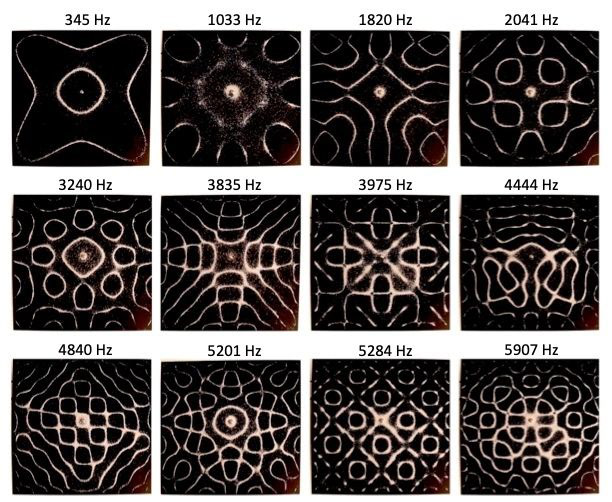


Generative Cymatics - Music Visualisation
Continuing with my exploration into cymatics I worked in TouchDesigner to create a network capable of generating close approximations to a Chladni plate, able to recognise and interpret frequencies of audio tracks and relay that information into a particle-driven visualisation.
Continuing with my exploration into cymatics I worked in TouchDesigner to create a network capable of generating close approximations to a Chladni plate, able to recognise and interpret frequencies of audio tracks and relay that information into a particle-driven visualisation.
Research
As I'd already conducted extensive research into cymatics in previous projects my main focus for this one was refreshing my knowledge, as well as developing appropriate techniques to be used in TouchDesigner through the use of online tutorials, discussing methods with the community base - who were extremely helpful, and experimentation.
This video was the primary reason I became fascinated with cymatics, and served as both inspiration and aspiration when conducting my own experiments in the field.
The creators of the Cymatics video above also provided a 'behind the scenes' which helped with understanding the process they undertook to create the video.
I also researched other aspects of cymatics, and visualising sound to gain a better understanding of the field.

Several examples of patterns generated on a Chladni plate with their appropriate frequencies which would serve as a guide and reference for the project.

A traditional set-up for conducting Chladni plate experiments using a plate, synth, microphone, and fine grain salt.
Developing the network
Initial tests were rough and used as a method of gaining a better understanding of the process, however over time I was able to refine the network into a visual aesthetic I would be happy with.
Initial tests were rough and used as a method of gaining a better understanding of the process, however over time I was able to refine the network into a visual aesthetic I would be happy with.

The final iteration of the cymatic network.

This section converted the audio into mathematical data which would be used to drive the particles, with the three top rows focusing on interpreting high, middle, and low range frequencies, respectively.

I needed each frequency to generate a mathematically appropriate pattern to be used as a map for the particles to attract to, so used a combination of Python coding, various Math CHOPs and (towards the end of this section) level adjustment and mirror components. The initial part of this section was driven by the data created in the previous section and updated as the audio played.

The patterns created in the previous section were used as attractors for the particles which would form the base visualisation. This section generated the particles and modified their behaviour. Initial areas of concern were the particles sticking too much, not moving, clumping at the edges of the design and not reacting as sand would on a Chladni plate, however with extensive experimentation I was able to resolve these issues.

This was the Python code used to control the particles.

Finally, I needed to generate a visual result of the network to actually see it, which was done in this section. The ramp1 and lumablur1 on the bottom-right were added just prior to the export and provided a soft vignette which served a personal aesthetic but also ensured attention was drawn to the centre of the visual space.
When I'd achieved the desired result, I exported the TouchDesigner renders to After Effects, added some basic stylistic elements (levels adjustment, chromatic aberration over time, a border and text), and then compiled them with their relevant audio tracks in Premiere Pro as I'd overlooked exporting the visual renders with the audio embedded - however this wasn't an inconvenience as it allowed for extra control over editing the video and audio.
The End Result
Below are the results of my experimentation and exploration. I thoroughly enjoyed working through this project and seek to improve the network over time. The songs were picked by my Facebook followers and prioritised for their frequency strength, clarity of beat and general popularity.
All videos are best watched at full (4k) resolution.
All videos are best watched at full (4k) resolution.






